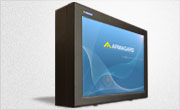Train Station Digital Signage
Posted by: Richard Williams | Posted on: | 1 Comments
Train stations were one of the earliest users of digital signage, with screens being used in major network stations for all sorts of reasons. With high levels of people using busy mainline stations, a need to communicate detailed information, digital signage around train stations has benefits for train operators, advertisers and customers.
The customer experience
One thing that is integral to a customer’s experience at a train station is time. Train arrivals and departures govern the user experience, and keeping abreast of any changes in timetables is essential for most commuters. When digital signage first developed, it soon replaced the traditional mechanical boards that provided timetables and schedule changes around train stations. Because train operators can upload information immediately, customers can be told in real time as soon as news of a delay comes in, and importantly, how long this delay is.
For customers on the platform, outdoor digital signage screens can keep them informed of a train’s progress with expected arrival times, displayed in minutes.
Operators
Keeping customers happy is integral for train operators. In many countries, train companies are much maligned due to delays. Providing up-to-the-minute information helps improve customer relations and reduce complaints.
Digital signage also helps make services more efficient, which in turn can reduce delays. When customers and staff know precisely what time trains are arriving there is less chance of trains being kept waiting at stations. Digital signage can help with important communication to both customers and staff, helping to steer people to the correct location when making platform changes.
Advertisers
The footfall in stations can be extremely high, especially during peak hours in the morning and afternoon. This large influx of people provides advertisers with good opportunities to reach a wide audience. Furthermore, because of the scheduled nature of commuting, advertisers can tailor digital signage content to meet the audience’s needs, such as fast food restaurants promoting breakfast offers in the morning. Other tailored items do well around stations too, such as books, a common commodity promoted on train station digital signage, due to the desire people have to read when travelling.
Post shortlink:
Popular Products
LCD Enclosure
Need armor for your LCD/LED screen(s)? Outdoors or inside the versatile LCD enclosure protects against thieves, vandals & the weather. Installation idea: NFL stadiums.
Outdoor Digital Signage
Exclusive 46” outdoor screen protection. Dubbed the ‘Totem’, due to its distinct design, it repels damage threats, but attracts audiences. Installation idea: Drive-thru restaurants.
Portrait Flat Panel Enclosure
Safeguard your eye-level advertising display screen(s), indoors or outdoors. Completely customizable, add exciting features like touch screen technology. Installation idea: Restaurant frontages.
Indoor Digital Signage
Popular purchase for retail outlets! Great for ‘point of sale’ persuasion, boost your brand with static & motion advertising from a single unit! Installation idea: Mall of America.




